A yoga history in a mustard seed
by Heather Elton
This extraordinary mural painting of Avalokiteśvara, or Padmapani, a bodhisattva who embodies the compassion of all Buddhas,
survives from early medieval India, preserved in the interior of the rock-cut Buddhist monastery of Ajanta. C. 477 CE. Maharastra, India.
Who is Siddhārtha Gautama Buddha?
c. 563 – 483 BCE
I FIRST HEARD ABOUT THE BUDDHA WHEN I READ HERMAN HESSES’S SIDDHARTHA. Even at 14 years old and was intrigued by the idea of a river appearing to be the same river, yet realising that the water was constantly changing. I understood the concept of impermanence, that all things are in a state of transformation and change.
Siddhārtha Gautama Buddha was born into an aristocratic family in the Śākya clan, in Lumbini, a place now located in southern Nepal, but during his lifetime the current day borders between India and Nepal had not yet been annexed by the British. Most people called him ‘Gautama’, but his disciples address him by other titles, especially ‘Bhagavat’, meaning a Blessed Lord; and Buddha, ‘the Awakened One. Siddhārtha refers to ‘one who is accomplished’. He apparently called himself ‘Tagathata’ – the one who is like that’, always referring to himself in the second person (to emphasis the notion of ‘selflessness’. Gautama is also known as Śākyamuni Buddha, the ‘first’ Buddha, or the ‘historical’ Buddha. He is described in the Bahiya Sutta, Udana 1:10 – Ireland 1997, as “pleasing, lovely to see, with calmed senses and a tranquil mind, possessing perfect poise and calm.”
Buddhist literature and dharma are as vast as an ocean and it’s impossible to do them justice here, so this is an attempt to give a brief account of the life story of Gautama Buddha and the main ideas of Buddhism. My deep apologies for any misrepresentation of the Dharma.
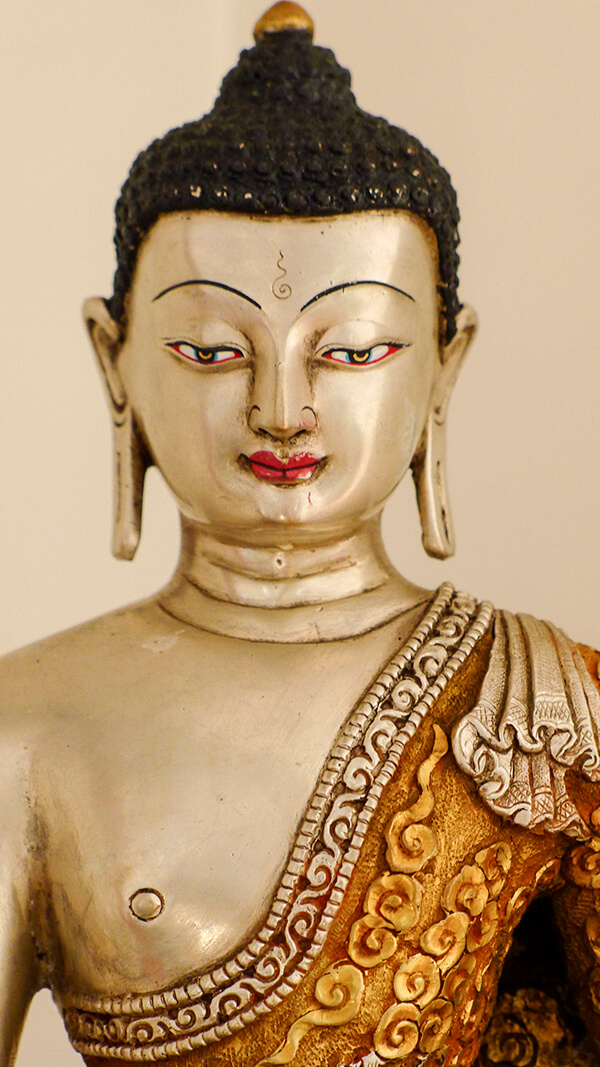
Śākyamuni Buddha from Upper Mustang, Nepal. Private collection of Heather Elton.
WHEN STUDYING THE LIFE OF GAUTAMA, SEARCHING FOR THE PERSON BEHIND THE LEGENDS AND TEACHINGS, it seems important to place him in the cultural context of ancient India, otherwise we’ll miss the essence of the Buddha’s message. Gautama lived during the exciting time of the early Upanishads and the Renunciate Movement where philosophers were asking the ‘big questions’ about life and early ascetic yogis left their worldly life to seek spiritual salvation in the jungles and forests. (See A History of Yoga Pt. 4 for details.) It was the Axial Age, the Age of Philosophy, an innovative time with profound new ideas, where yogis questioned everything that was considered ‘truth’ in society and investigated the nature of mind.
In the 5th century BCE, the Śākya kingdom was a dense woodland, on the northern edge of a great civilisation linked by trade routes bringing travellers from as far away as South India and Persia. Further north were dense jungles, foothills and the high passes of the Himalayas that would one day be called Tibet and Nepal. People lived in fear of dangerous wild animals, like tigers and lions, elephants and rhinoceroses. Bandits and tribesmen were known to attack merchants on the trade routes, who often traveled with several hundred ox-drawn wagons. Pakistan and Kashmir were Persian territories, and on the distant north eastern border a fierce war was raging with the Greeks, who were developing their own philosophy under the guidance of Sophocles and Socrates – all born around the time of Gautama’s birth.
Large cities, like Vārāṇasī (known as ‘Kāśī’ at the time) with 100,000 inhabitants, were booming industrial centres and among the most prosperous in the world. Landowners amassed huge estates tended by hired workers and slaves. Wilderness saw trees felled and marshes drained for the new agricultural industry. Most inhabitants rarely left their villages, preferring to watch travelling fairs and theatrical troupes with dancing and singing, who came to them. Śākyan villagers lived with their animals in fragile shelters of bamboo plastered with mud, as many Indians and NePāḷis still do today. There was a surplus of healthy food, but life was hard. Gautama was no doubt aware of the never-ending cycle of the seasons and the demands of the harvest that regulated the lives of even the Śākyan elite. They suffered; caught in the wheel of saṃsāra.
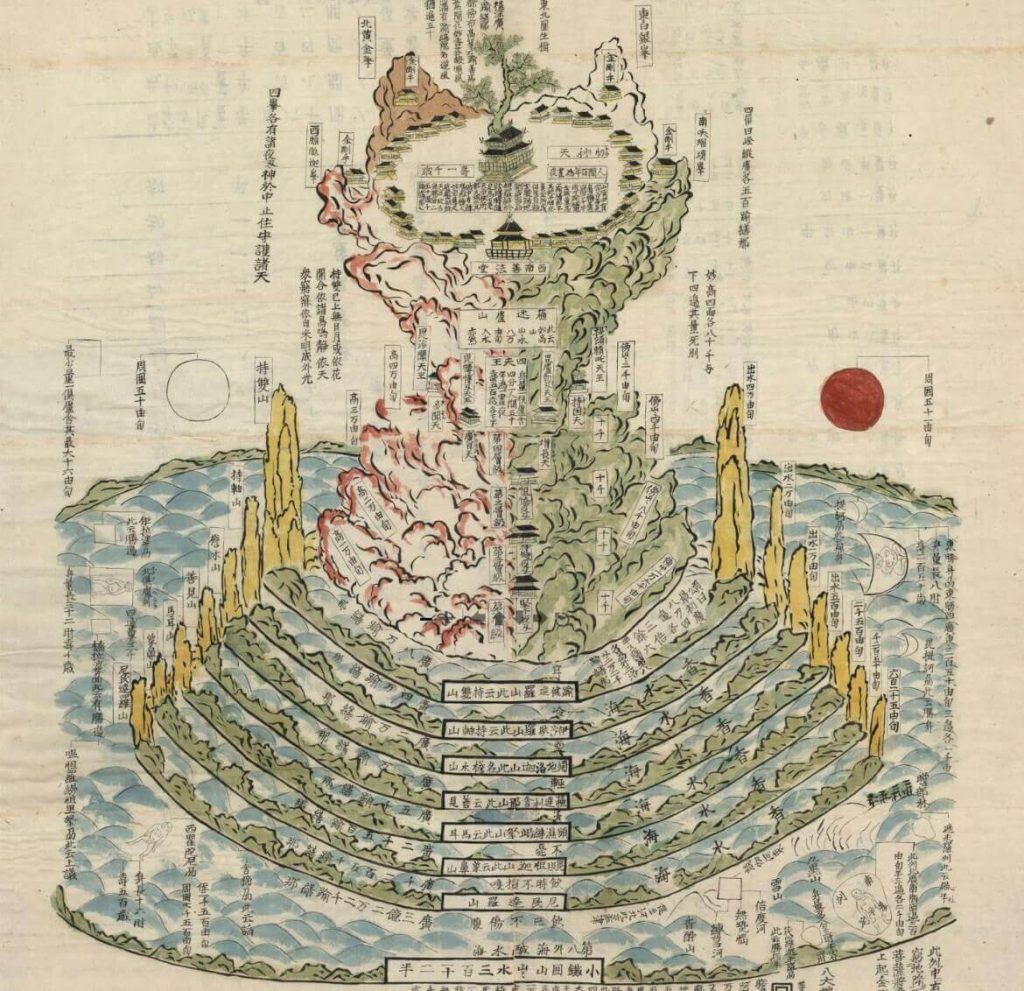
1860s Edo Period Japanese Buddhist cosmological Map of Mount Meru.
Ancient Indians perceived the world very differently that we do today. Their concept of the universe was shaped by Vedic and Upanishadic thought and staggers the imagination. It was seen as an infinite cosmos, incredibly old and inconceivably vast – boundless space without a beginning, existing for innumerable aeons, expanding and collapsing in a giant cosmic cycle. Time was measured in Hindu and Buddhist cosmology as aeons, or kalpas. 1 kalpa = 4.32 billion years. The early Buddhist discourses of the Sutta Piṭaka, describe Nature as having a vivid presence, where gods and demons were not just ornamentation but embodied natural forces, capable of supernormal powers and miraculous events.
The Pabbata Sutta (15.5) records Gautama’s discourse on the beginnings of saṃsāra and the idea of time in this boundless universe. Sitting beneath the infinite stars of the night sky, he asked his disciples to “imagine a mountain of rock, five miles long, high and broad. If, at the end of every hundred years, a man came to brush the mountain just once with a fine cloth woven from Kashi, the mountain would eventually be worn away, he said, but, ‘the aeon would still not have come to an end. And, not just one aeon has been wandered through, not just a hundred aeons, or a thousand, but from an inconceivable beginning come the wanderings of each life. Long have you thus experienced stress, pain, loss, swelling the cemeteries – enough to become disenchanted with all fabrications, enough to become dispassionate, enough to be released from saṃsāra.” Gautama told his followers that in their previous lifetimes they had left behind “a pile of bones higher than a mountain” and shed “more tears than the waters of the four great oceans.”

Illustrated Buddhist manuscript of the previous lives of the Buddha from the Buddha’s Birth Tales, known as Jatakas. British Library (Public Domain).
At the time of the historical Buddha, India was an ‘oral’ culture and his teachings were remembered by monks (untrained in memorisation skills like the Brahmins) through the centuries, until they were finally ‘written’ down in the Pāḷi Cannon, in Sri Lanka in the first century BCE, 300 years after his death. Sanskrit texts also appeared around that time. The earliest collection of Buddhist sacred literature is the Pāḷi Tipiṭaka (Three Baskets) that form the basis of Theravada Buddhism in present day Sri Lanka and Southeast Asia. The Tipiṭaka includes the Vinaya Piṭaka (Discipline), the Sutta Piṭaka (Discourses of the Buddha), and the scholarly Abhidharma that comprises the philosophical teachings of Buddhism. It’s far too complicated to discuss in this essay.
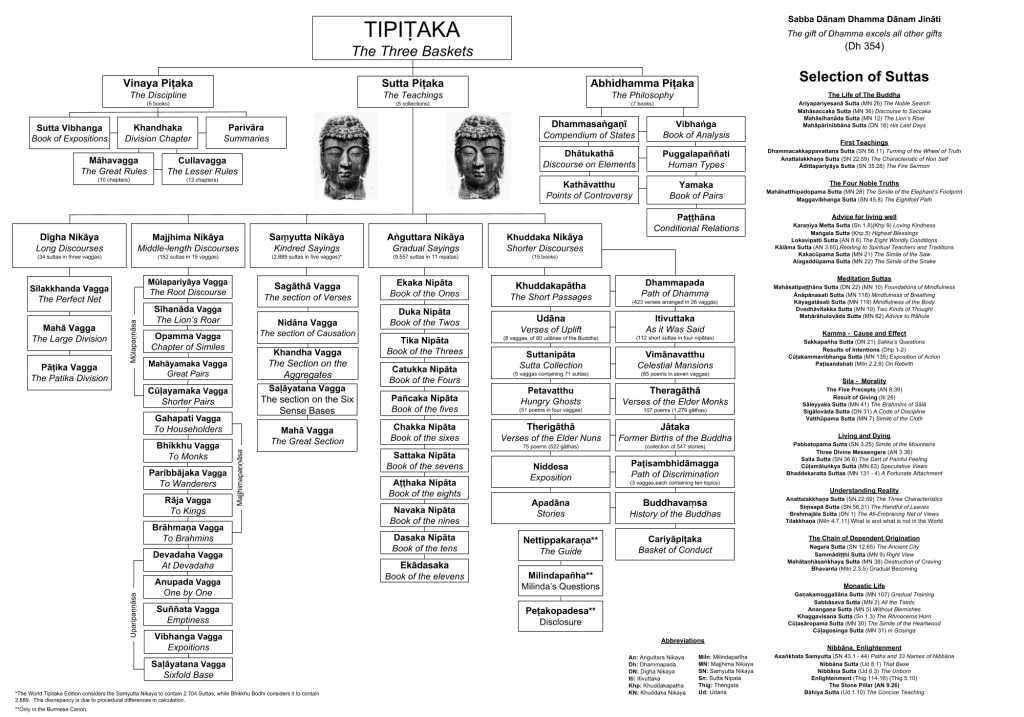
Map of the Tipiṭaka (Three Baskets), the earliest teachings of the Theravaden school of Buddhism in the Pāḷi Cannon.
Whatever truths the Tipiṭaka contains were reshaped when the original palm-leaf manuscripts, of both the Pāḷi and the Sanskrit scriptures, decayed in the tropical humidity and had to be copied and recopied, repeatedly. Few Buddhist manuscripts are more than 500 years old. Older rock-cuttings and inscriptions exist, but the earliest evidence about Gautama, that we can reliably date, comes from inscriptions left by the Buddhist Emperor Aśoka, around 150 years after Gautama’s death.
During my research for this article, I read Ashoka and Buddha and the Sahibs by Charles Allen. Fascinating books about the role of the East India Trading Company in India. I had no idea that prior to the British arriving in India that there was no pre-Islamic history and that they reintroduced Buddhism to the subcontinent. No history prior to 1206 CE. I thought that all members of the EITC were racist and greedy, but it turns out that there were a few exceptional people who truly loved India. Often involving great personal sacrifice, administrators, archeologists, linguists and Indologists (some with PhDs in Sanskrit and Persian from Oxford in the 18th century) and historians uncovered the remains of Buddhist culture destroyed by the Muslims and Brahmins and reintroduced it to the subcontinent. It took over 200 years of meticulous scholarship, partly due to indifference by the Company and the British Crown, but eventually the splendour of Askhokan empire, with its numerous Ashokan pillars and pre-Sanskrit script, and famous sites like Sarnath, Bodhgaya, Gandharva, etc. were excavated and eventually restored. Buddhism was put on the map and spread throughout the world.

The pillars of Aśoka are a series of columns built at Buddhist monasteries, many important sites from the life of the Buddha,
and places of pilgrimage, by the Mauryan Emperor Aśoka during his reign from c. 268 to 232 BCE.
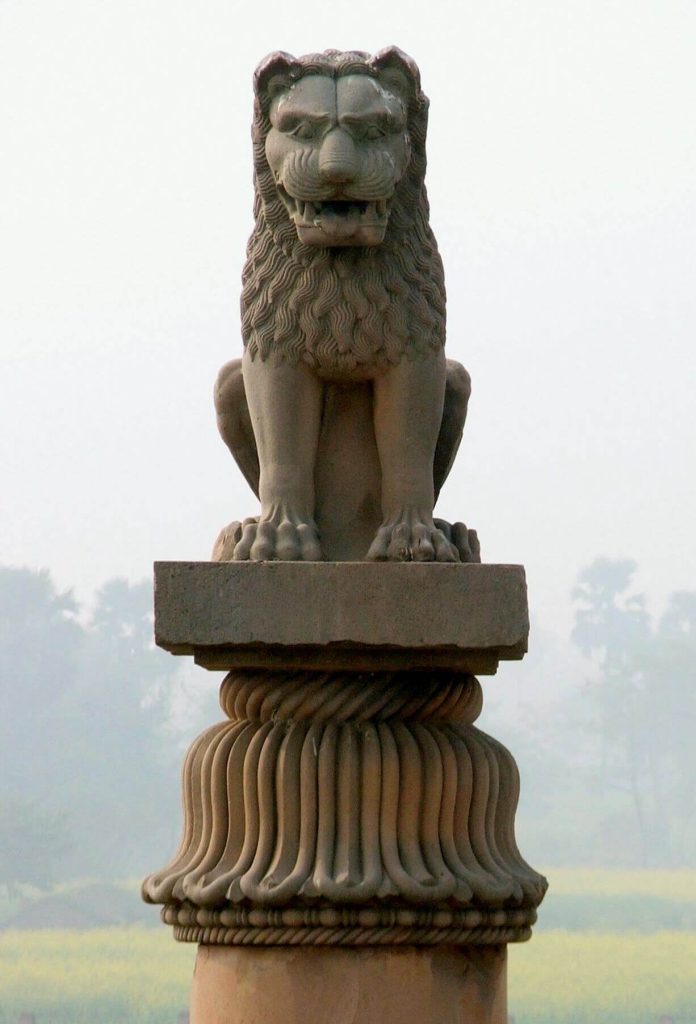
The first Lion capital was built at Sarnath, Uttar Pradesh, to commemorate the site of the Buddha’s first sermon.
The Lion capital is a polished sandstone carving of four lions atop an abacus (the slab forming the top of a column).
The lions are facing in four directions and on the abacus are eight images. Immediately below each lion is a dharmachakra,
or wheel, with 24 spokes. This wheel has been incorporated into the national flag of India. Between the wheels are four animals –
a lion, a horse, an elephant and a bull. Falling from the abacus is an upturned, bell-shaped lotus flower. The capital is in the museum in Sarnath.
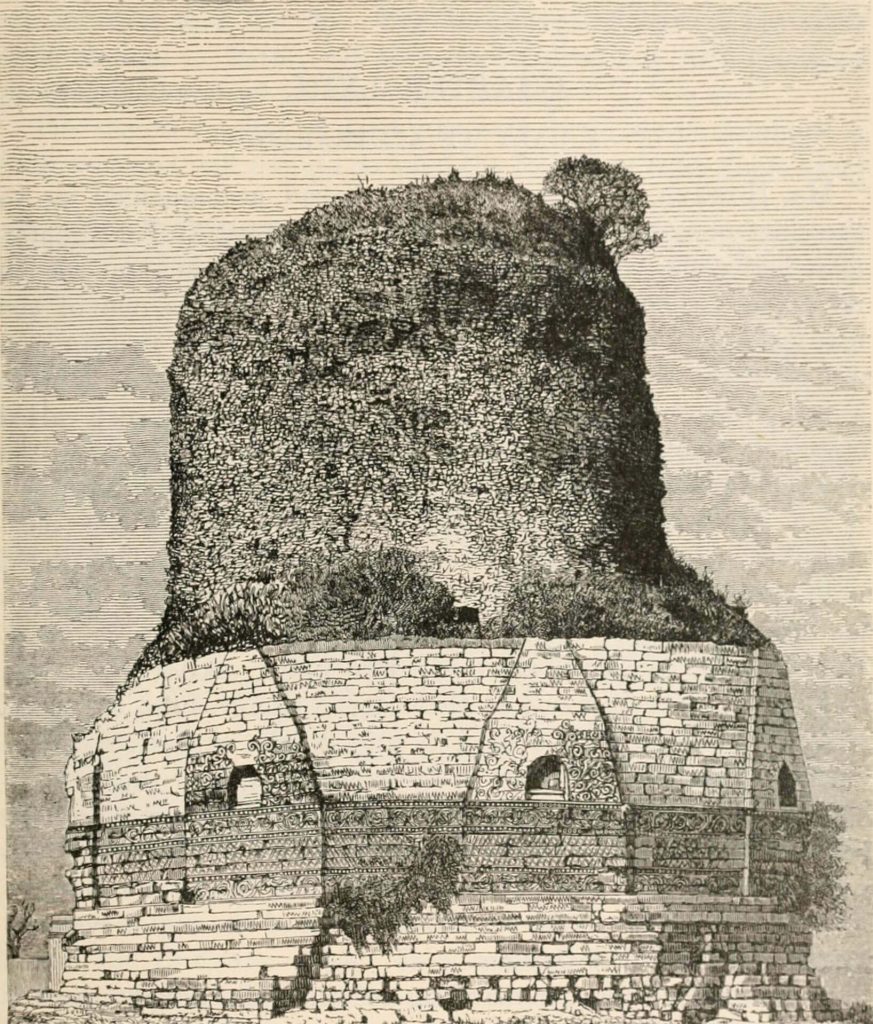
Above, A drawing of the Dhamek Stupa from 1891.
Dhamek Stupa commemorates the site where Buddha gave his first sermon after his awakening.
Built in 500 CE to replace an earlier structure commissioned by King Aśoka in 249 BCE, the stupa is said to be where, in the 7th CE,
two pilgrims visited Sarnath and stated that the kingdom of Yarakasi, or Benares, was 667 miles in circumference;
that in the city there were 30 Buddhist monasteries, which supported 3000 monks; that the great tower was built by Asoka;
that the Deer Park monastery was divided into eight parts, and contained palaces; that each of the niches in the tower held a statue of Buddha
in embossed gold; that west of this was the tank where Buddha bathed; and that, farther along, was the tank where he washed his monks water-pot;
and, still farther, the one where he washed his clothes.

Above, Dhamek Stupa as it exists in Sarnath today. Photo Copyright Heather Elton 2014.
So, there is very little material evidence to be found in the legends that make up the life of the Buddha. Even the popular story that he grew up as a Prince, living a privileged life in luxury before taking on extreme asceticism, is disputed by historians who regard this account as fiction. Some even doubt that we can say for certain that an historical individual called Gautama Siddhārtha Buddha existed at all. We will never know for sure what the historical Gautama ‘really’ did or said. The best we can hope for is a plausible account.
L I F E O F T H E B U D D H A
OFTEN THE LIVES OF SAINTS, DIVINE BEINGS, OR HOLY PEOPLE, INCLUDE MIRACULOUS HAPPENINGS or significant events. There are the 12 main events that define Siddhārtha as ‘Buddha’ (and serve as the main structure of this essay.)
12 main events in The Life of the Buddha:
1. Descent from Tushita Heaven
2. Miraculous Conception
3. At Birth, he walked 7 steps. Lotus flowers bloomed.
4. Childhood
5. Princely Life
6. The Great Renunciation
7. Austerity
8. The Middle Way
9. Overcoming Māra’s demons
10. Enlightenment
11. Teachings
12. Passing into Mahaparinirvāṇa
Let’s take a look at each one.
1. Descent from Tushita
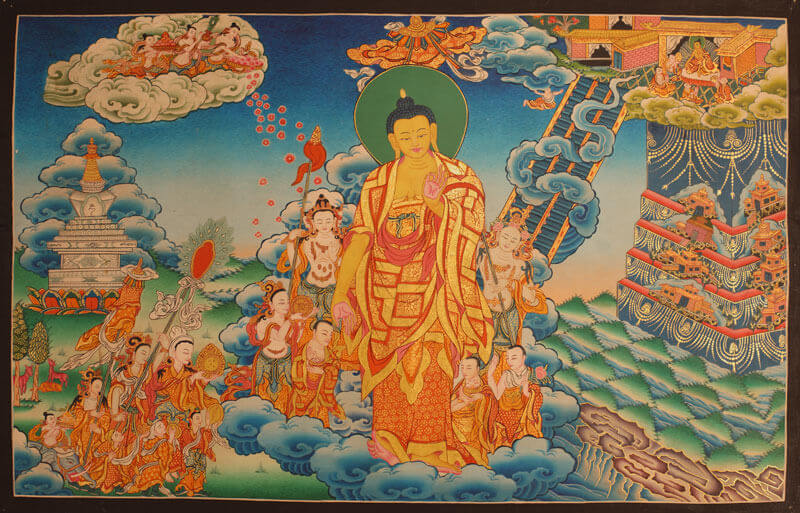
Śākyamuni’s descent from Tushita.
Tushita means ‘contented’ or ‘joyous’’ in Sanskrit and is the sixth heavenly realm in the Buddhist tradition. Tushita is reached through sādhanā, or advanced meditative attainments. Gautama had many previous lives, during which time he accumulated great merit and the positive karma to reincarnate as the Buddha. The stories of those lives are told in The Jatakas (Birth stories) that are part of the Sutta Piṭaka. The numbers vary, but there were around 27 buddhas who existed before Gautama. Dīpankara Buddha is worshipped in Nepal and is believed to have lived on Earth 100,000 aeons ago. Buddhists believe that many more will appear in the future. Maitreya is said to be the next Buddha.
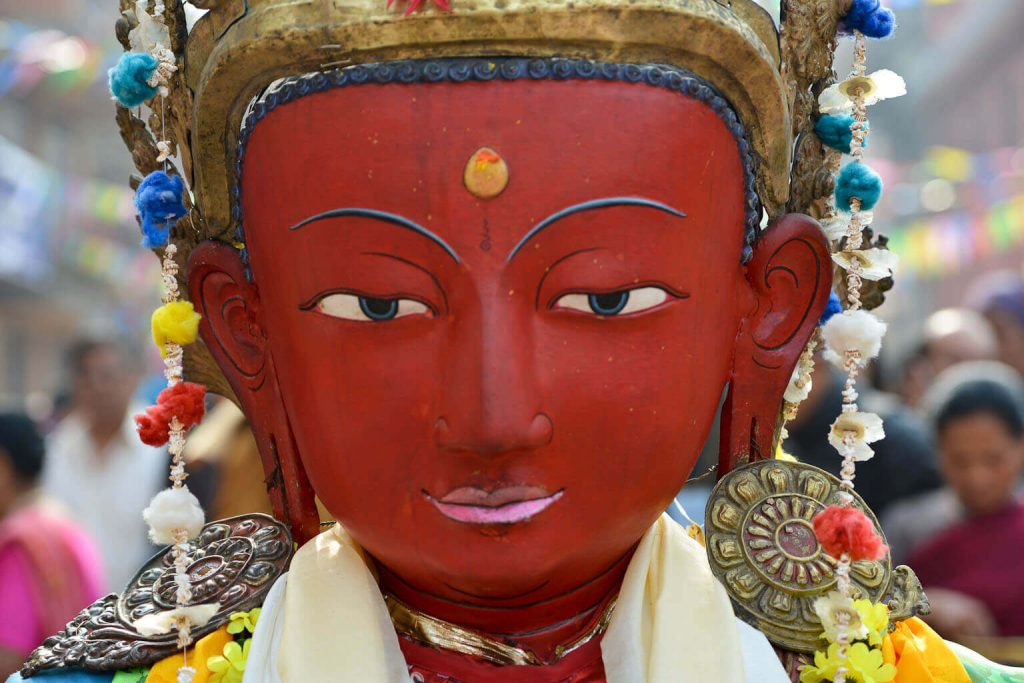

Above, Gods walking amongst humans. Dīpankara Buddhas at the Samyak Festival in Nepal.
Once every five years, the Dipankara Buddhas in the Kathmandu Valley are paraded to the Naga Bahal in Patan. © Heather Elton.
Dzongsar Khentsye Rinpoche tells us in his book, India‘s Buddhist Holy Sites, that what is essential to know about Siddhārtha is that he came to this earth as an ‘ordinary person’.
“Siddhārtha was a man with all the same problems and hang-ups we have, but he managed to remove them all, and having done so, became anything but ordinary. This embraces one of the core Buddhist teachings on Buddha Nature (tathāgatagarbha) that lies at the heart of Mahāyāna Buddhist philosophy. By telling us that Siddhārtha started out as an ordinary person, Buddha is making it quite clear that he was not, and never would be, a primordially perfect God or almighty Creator. There are many stories in the Jatakamala Sutra about how Buddha was reborn over many lifetimes as different types of sentient beings, like a bird, a turtle, or a fish, and that throughout these incarnations, he suffered all the same emotions and problems we do. This ordinary person then undertook various forms of training, involving almost unimaginable spiritual and physical hardship, until eventually he discovered the truth.”
2-5. Miraculous Conception, Birth and Princely Life

Māyādevī dreams of a white elephant. Miraculous conception of Gautama Buddha. Sunapati Thangka School, Nepal.
Even though Siddhārtha was an ‘ordinary’ human, legends say that he was conceived when he entered his mother’s womb as a white elephant in a dream. While his mother, Mahāmāyā, was travelling to her parent’s home, she felt birth pains and took shelter in a ‘pleasure garden’ in Lumbini. Feeling her child coming she grasped a branch of a tree (like a Yaksha or female goddess). Siddhārtha emerged from her right side, painlessly and cleanly, was lowered to the ground by the Gods, and then, immediately, walked seven steps. Where his feet touched the earth, lotuses bloomed. Seven days after the birth of the Bodhisattva, his mother died and was reborn in Tushita heaven.
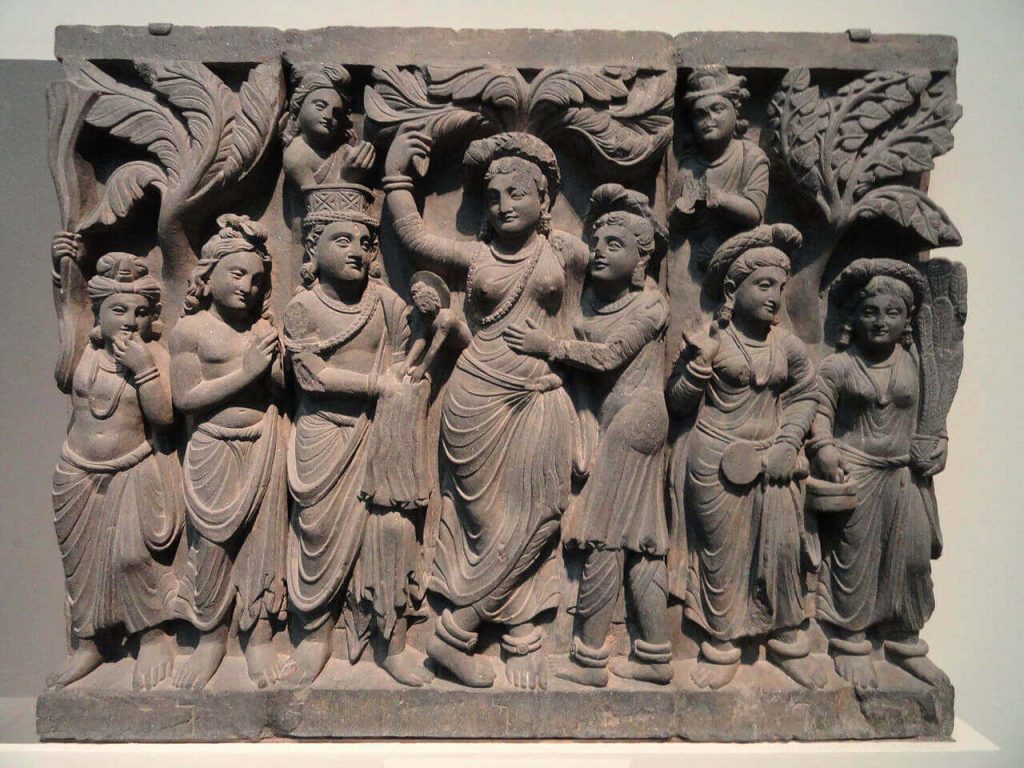
Ancient schist of Buddha’s birth from his mother’s side. Queen Maya, who has the garments and hair style of a Roman matron,
stands in an Indian posture associated with female nature spirits (yakshas) who grasp tree branches to make them bloom.
Gandhara Kushan dynasty, late 2nd – early 3rd century CE.
At the time of his birth, a Vedic astrologer prophesied that Siddhārtha would either be a powerful king or a renowned spiritual person. His father, Śuddhodana, king of the Śākyas, did everything in his power to shelter his son from the suffering of the real world, in hope that he would become a King. Siddhārtha was raised as a Prince and enjoyed a privileged life. Indian palaces of this era were luxurious, with cool, spacious apartments, courtyards and exotic gardens with flowering trees and ornamental birds such as peacocks. Wealthy families owned gems, spices and lustrous black pottery. The Jataka birth stories describe lotus ponds filled with blue lotuses, others with white and red lotuses, blooming purely for Siddhārtha’s enjoyment. The prince dressed in fine robes of muslin from Vārāṇasī. He was anointed in rich perfumes and used only the best sandalwood paste to cool his skin in summer. There were no end of childhood games and he had the finest education in the land.
At age seven, boys of the Kshatriya, or warrior caste, trained in the skills of a warrior and Siddhārtha became proficient in sword fighting, archery and wrestling. In early childhood, a friend shot a swan and Buddha cared for it showing early signs of compassion. His abilities impressed his teachers and he rapidly learned a wide range of subjects, including mathematics and languages. He spent the rainy season immersed in solitude, poetry and music. He excelled in all things, surpassing his fellow students, and even going beyond what his teachers could teach him. Siddhārtha also enjoyed concubines to indulge his sensual pleasures. At sixteen, he married Yaśodharā (who later became a disciple and is considered an arahatā), and together they had a son, Rāhula. Several of his companions became later prominent members of his order.
6. Renunciation
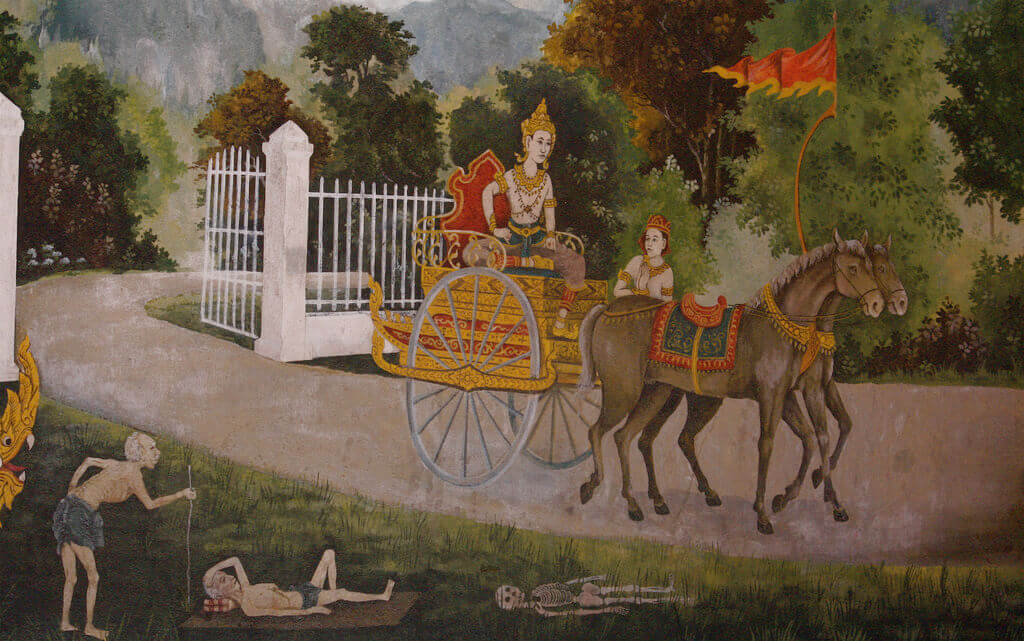
Siddhārtha leaves the palace for the first time at age 29 and sees four sights that changed his life forever
and led to his realisation of the impermanence and ultimate dissatisfaction of conditioned existence.
The popular legend is that Siddhārtha didn’t leave the palace until he was 29. When he finally ventured into Kapilavastu in his chariot, he saw four sights that would change his life. An old man, a sick man, a corpse, and a wandering ascetic, or śramaṇa yogi, with shaven-head, mud-yellow robes and alms bowl. This event is known as The Four Encounters or The Four Sights and classical biographies refer to it as the cause for Gautama’s renunciation. Some scholars explain his renunciation as the accumulative effect of being a householder for someone with merit. Either way, the result was existential crisis.
Siddhārtha was devastated to discover such suffering existed, that he was powerless to protect his subjects, and that ordinary people seemed oblivious to the inescapable decline into old age, sickness and death. The Attadanda Sutta, Gautama describes Śākya life as a fight for survival and contains a vivid description of the shattering emotions he felt.
“Fear is born from arming oneself.
Just see how many people fight!
I’ll tell you about the dreadful fear
that caused me to shake all over:
Seeing creatures flopping around,
Like fish in water too shallow,
So hostile to one another!
Seeing this, I became afraid.”
– (from “Gautama Buddha: The Life and Teachings of The Awakened One” by Vishvapani Blomfield)
Gautama vowed to find a solution to the fundamental problem of human existence – the problem of Duḥkha (suffering, decay and impermanence of life) compounded by Saṃsāra (the eternal cycle of life, death and rebirth).
Dzongsar Khyentse Rinpoche points out in his book, What Makes You Not a Buddhist:
“Upon first hearing the story of the dawn of Siddhārtha’s realisation, we might think that he was remarkably unsophisticated. It seems strange to hear of a prince, raised to lead an entire kingdom, asking such simplistic questions. But we are the ones who are naive. In this information age we are surrounded by images of decay and death—beheadings, bullfights, bloody murder. Far from reminding us of our own fate, these images are used for entertainment and profit. Death has become a consumer product. Most of us do not contemplate the nature of death on a deep level. We don’t acknowledge that our bodies and environment are made up of unstable elements that can fall apart with even the slightest provocation. Of course, we know that one day we will die. But most of us, unless we have been diagnosed with a terminal illness, think that we are in the clear for the time being. On the rare occasion that we think about death, we wonder, How much will I inherit? or Where will they scatter my ashes? In that sense we are unsophisticated.”
Many people find it difficult to understand how he could leave his wife and son. It was a matter of responsibility. If we are to suffer until death – anxiety, decay and illusion – then what’s the point? Siddhārtha wanted to find a way out of that for everyone. And it was a big sacrifice for him. He enjoyed his privileged life. He had to forsake a lot of things, even his beloved son. He left the comforts of the palace, his regal garments and jewellery, kissed his wife and son goodbye as they lay sleeping, and slipped out into the night. After his renunciation, wherever he went Gautama was “anxious, fearful and on alert.”
7-8. Ascetic Life and The Middle Way
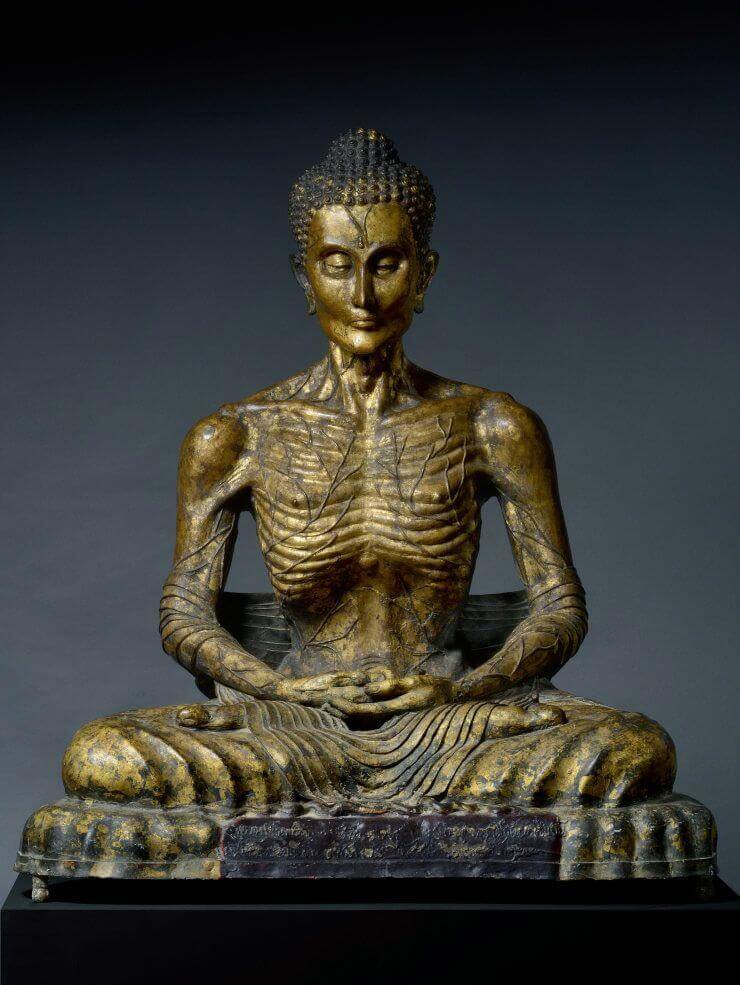
Emaciated Śākyamuni Buddha after doing extreme tapasyā practices that led to his discovery of the Middle Path.
Bronze statue. Thailand, Rattanakosa Kingdom. 19th CE.
In the early Upanishadic era preceding Siddhārtha’s birth, holy men in the Ganges Valley were exploring methods of spiritual practice called ‘yoga’, and it would have been natural for Gautama to meet them and discuss his questions about life. The beginnings of his spiritual search took place within a subculture of fellow seekers –śramaṇas – who begged for food and lived on the edges of mainstream society.
In biographical event known as The Great Tonsure, Gautama cut off his long hair with a sword as an act of renunciation from worldly life. He renounced his possessions, status and caste, to become one who has ‘gone forth’, who truly lives in serenity, does good actions, is harmless and has compassion for all living beings. Gautama wore a mud-yellow robe of coarse muslin fabric draped over his shoulder and around his midriff, perhaps found in the charred remnants of the cremation grounds. These robes, along with a dried palm leaf bowl, a needle and thread, a rope around his waist, a razor and a water-strainer, were the sum of his possessions.
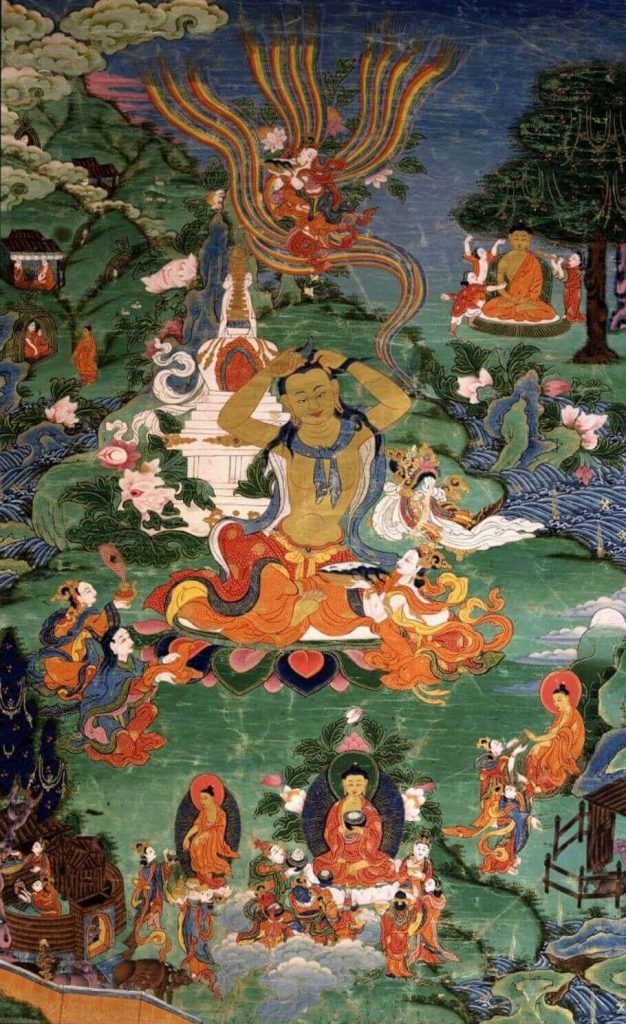
Gautama Buddha cuts his hair in a biographical event known as The Great Tonsure, to signify his renunciation from worldly life
and becoming a śramaṇa yogi. Courtesy Rigpa.
Gautama studied with leading Vedantic teachers and absorbed the latest philosophical ideas being debated at the time; Sāṃkhya (For details, read A History of Yoga Pt. 5) in particular, and he was influenced by the Jain concept of Ahimsa (non-harming) and Karma. It wasn’t long before he mastered all they had to teach. Gautama immersed himself in the extreme practices of tapasyā yogis of the śramaṇa tradition – intense prāṇāyāma khumbakas and self-mortification of the body, including fasting. (For details, read A History of Yoga Pt. 4). He nearly starved to death, meditating and fasting for six years in a cave, before coming to the realisation that extreme practices did not work. They did not cut the root of desire which (he saw as the cause of suffering), nor did they enable him to attain mokṣa (liberation). He decided to walk his own path – the Middle Way.
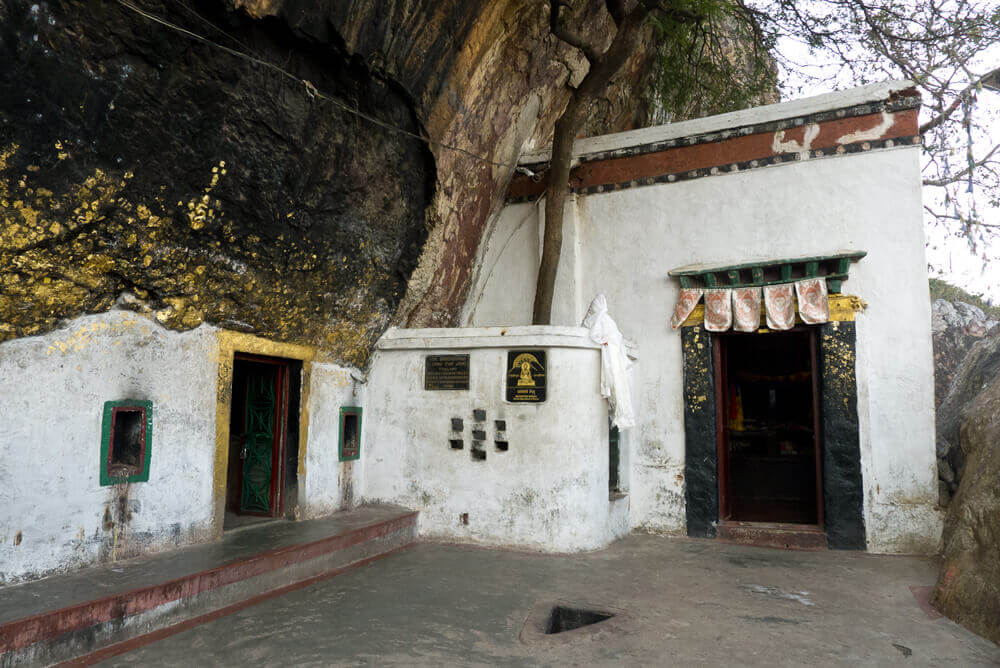
Dungeshwari Cave Temples, also known as Mahākāla Caves, are the three caves where Siddhārtha meditated and fasted for six years,
nearly starving to death, before coming to the realisation of the Middle Way and continuing his journey to Bodhgaya. Bihar, India. Photo Heather Elton
The Dhammacakkappavattana Sutta (Setting the Wheel of Dhamma in Motion), SN 56.11, describes the Buddha’s realisation of the Middle Way.
“There are two extremes that are not to be indulged in by one who has gone forth. Which two? That which is devoted to sensual pleasure with reference to sensual objects: base, vulgar, common, ignoble, unprofitable; and that which is devoted to self-affliction: painful, ignoble, unprofitable. Avoiding both of these extremes, the Middle Way realised by the Tathagata leads to calm, to direct knowledge, to self-awakening, to Unbinding.”
When the emaciated Siddhārtha emerged from the cave by the banks of the Niranjana River, a young girl offered him some rice and milk to break his fast. When he was done eating, Siddhārtha placed the bowl in the river and said, “If today I’m able to attain full enlightenment, may this golden bowl swim upstream.” The bowl immediately did so. Siddhārtha walked to Bodhgaya and sat down on some kusha grass under a Bodhi tree to investigate human nature, determined not to get up until he awoke.
In one of the oldest sections of the Pāḷi Tipiṭaka, the Attadaṇḍā Sutta, shares an insight that determined what came next in Gautama’s life and shaped its future course. The ‘Thorn in Your Heart’ describes the anxiety Gautama felt at the time.
“This world completely lacks essence;
It trembles in all directions.
I longed to find myself a place
Unscathed – but I could not see it.
Seeing people locked in conflict,
I became completely distraught.
But then I discerned here a thorn
– Hard to see – lodged deep in the heart.
It’s only when pierced by this thorn
That one runs in all directions.
So if that thorn is taken out –
one does not run, and settles down.”
He understood that people create their own suffering through their efforts to alleviate insecurity and confusion; and he saw that he was afflicted, just as they were, by the thorn in his own heart. He understood that he needed to change himself in some radical, fundamental way.
9. Overcoming Māra
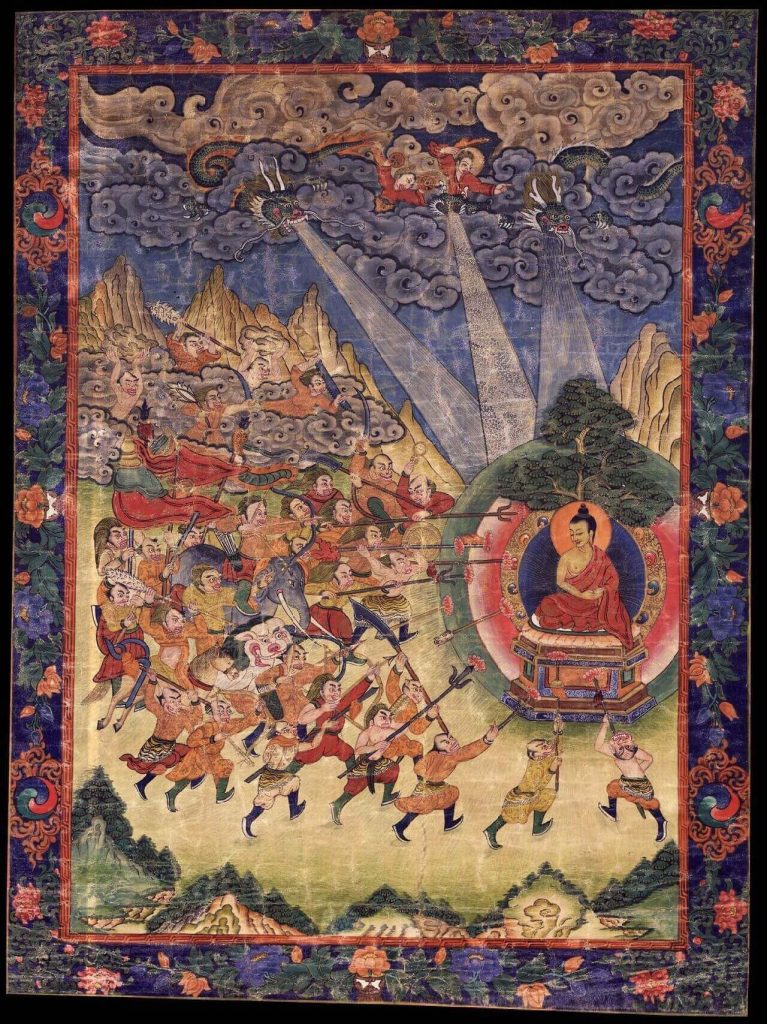
Māra (Lord of the Desire Realm) and his armies attempt to disturb Śākyamuni’s mind prior to his awakening
under the Bodhi tree at Bodhgaya, India. Courtesy Rubin Museum, NY.
As Siddhārtha sat in intense meditation, on what’s now called the Vajra Seat, or Diamond Seat, under a fig, or Pipal tree, known as the Bodhi Tree, in Bodh Gaya, India, he realised the solution to the problem of Duḥkha (suffering) and Saṃsāra (endless cycle of birth and rebirth). But, first, he had to defeat Māra, the lord of the realm of desire, or the realm of rebirth, who psychologically might represent our shadow.
Māra, manifested as a demon with thousand arms, each hand brandishing a deadly weapon, riding on the back of a celestial elephant. His fearsome army made eerie noises and used magical powers to generate fear – rain, hail, showers of fire, thunder, and an earthquake -, and celestial arrows of lust, anger and revenge, to distract the Buddha and keep him in saṃsāra. When they threw weapons at him, Śākyamuni transformed them into flowers. Māra sent his beautiful daughters, Desire, Pleasure and Delight, to seduce him, using dance, song and music as their arsenal to generate lust in the Buddha’s mind. Śākyamuni remained unshakeable. Māra’s final weapon was a disc which failed to harm the future Buddha. How was Śākyamuni able to transform them into flowers? Because he recognised the demons and their weapons as interdependent and empty in nature. The battle was over and Māra defeated.
10. Awakening
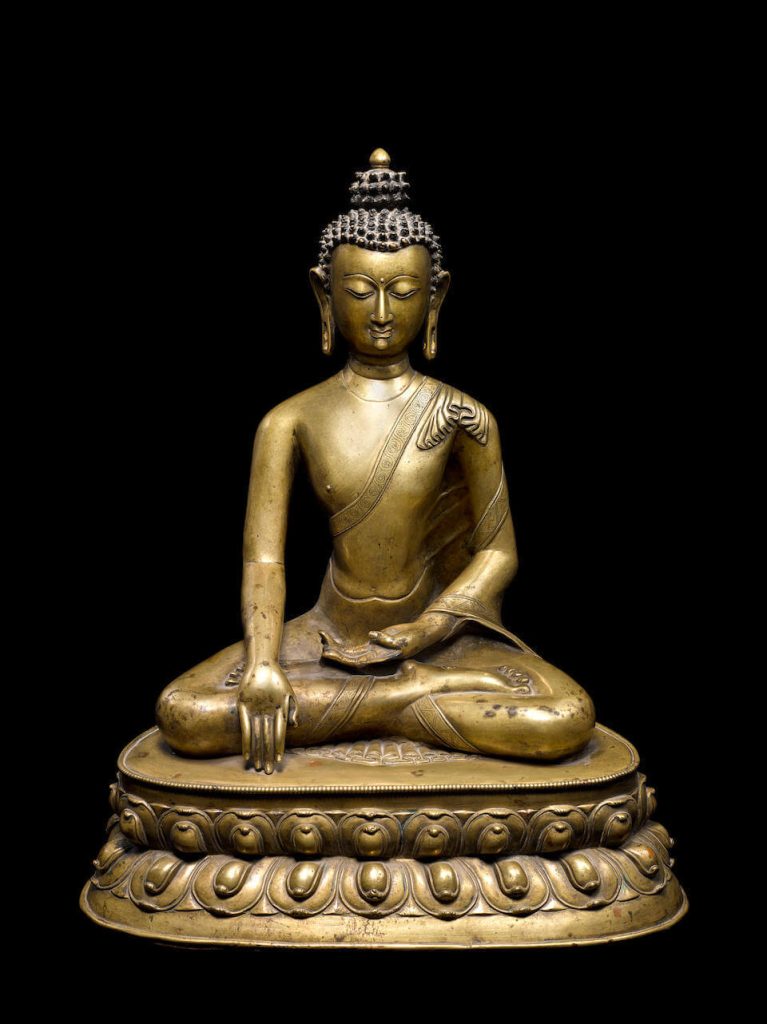
Śākyamuni Buddha, at the time of awakening, touched his right fingers to the ground in Bhūmisparśa mudrā
and said, ‘Let the earth be my witness.” Tibet, circa 13th century.
At age 35, after years of searching for the truth and six excruciating years of penance, Siddhārtha finally attained enlightenment. The Buddha never used the world ‘enlightenment’. ‘Enlightenment’ is a colonialist term that came into the lexicon in the 17th – 18th CE, during the Age of Enlightenment in Europe. The Buddha awoke. He awoke during the full moon under the Bodhi tree in Bodhgaya.
Siddhārtha’s awakening from the illusion of permanence gives us reason to refer to him as the Buddha, the Awakened One. Liberation is not about ‘attaining’ or ‘gaining’ something; rather, it involves the removal of obscurations that cover our already perfect Buddha Nature.
But what did the Buddha realise under the Bodhi tree? Dzongsar Khyentse Rinpoche says it succinctly in his book, What Makes You Not a Buddhist:
“Without a single scientific tool, Prince Siddhārtha came to the realisation that all form, including our flesh and bones, and all our emotions and all our perceptions, are assembled—they are the product of two or more things coming together. When any two components or more come together, a new phenomenon emerges—nails and wood become a table; water and leaves become tea; fear, devotion and a saviour become God. This end product doesn’t have an existence independent of its parts. Just by meeting, their character has changed and, together, they have become something else—they are ‘compounded’. Believing it truly exists independently is the greatest deception.
Siddhārtha realised that this applies not only to the human experience but to all matter, the entire world, the universe—because everything is interdependent, everything is subject to change. Not one component in all creation exists in an autonomous, permanent, pure state. So as long as something exists within reach of our mind, even in our imagination, such as a man with four arms, then it depends on the existence of something else. Thus, Siddhārtha discovered that impermanence does not mean death, as we usually think, it means change. Anything that changes in relation to another thing: even the slightest shift, is subject to the laws of impermanence.”
Impermanence is so obvious, but we just don’t see it.

Śākyamuni Buddha at the time of awakening under the Bodhi tree touched his right fingers to the ground in Bhūmisparśa Mudrā
and said, ‘Let the earth be my witness.” Thangka. Central Tibet, 12th CE.
At the moment of spiritual awakening, Māra’s last attack was to challenge Śākyamuni’s right to the Vajra Seat on which he sat. Māra asked, ‘How will anyone believe you?’ Buddha touched the ground with his right fingers in Bhūmisparśa mudrā, and summoned the earth to be his witness. Touching the earth signifies the Truth. It’s a gesture of humility that both honours the earth and allows us to ‘touch base’ with our naked, raw mind. We become entirely present and the mind is no longer distracted. The earth quaked and Māra and his army ran in disarray.
The mantra of Śākyamuni Buddha, in the gesture of Bhumisparsa mudrā, is:
oṃ muni muni mahamunaye swaha, or oṃ muni muni mahamuni Śākyamunaye swaha.
Om represents the cosmic vibration of the universe, while muni translates as ‘sage’ and maha means ‘great.’ The mantra, therefore, is typically translated as “Om wise one, wise one, supreme wise one, wise one of the Śākyans, hail!” It is also believed that the Śākyamuni mantra clears all negative karma accumulated throughout the kalpas, or eons.
The Buddhacarita (Acts of the Buddha), xiv.90, an epic poem written in Sanskrit on the life of Gautama Buddha, composed in the early second century CE, contains a description of what happened when the Buddha awoke:
“At that moment none gave way to anger, no one was ill or experienced any discomfort, none resorted to sinful ways, or indulged in intoxication of mind; the world became tranquil, as though it had reached perfection.”
The Buddha remained seated under the Bodhi tree for seven days without blinking.
Dzongsar Khentsye Rinpoche discusses Siddhārtha’s awakening in a video for his Bhumisparsha Project.
“Buddha is telling us that enlightenment exists and is achievable for anyone, and that defilements have to be and are removable. If the goal of enlightenment is not achievable and defilements are not removable, the path we’re trying to follow is, itself, deceptive and quite meaningless…if you are a sentient being, you also have the enlightened qualities of a buddha. That is why Buddha’s statement, that he, himself, managed to remove all his defilements to achieve enlightenment, is so momentous. Our job is to develop confidence in the fact that our own true nature has exactly the same potential as that of the Buddha, and that all we need to do to mature that potential is to follow Siddhārtha’s example and apply the right methods.”
After his awakening, Śākyamuni Buddha wandered in northeast India (current site of Bihar and Uttar Pradesh) as a mendicant yogi, giving talks in the parks at the edge of cities, performing occasional miracles, in the company of a growing band of disciples, who formed the beginnings of the first Buddhist sangha. His ideas were established through debate with other religious practitioners as he responded to their questions and the deep, unspoken assumptions they revealed. He invoked accepted beliefs, but turned them on their heads. He sharply criticised the culture of Brahminism with its rigid social stratification and magical thinking. He spoke out against the caste system and allowed women into his sangha. He had many wealthy patrons, but also questioned their motives for money and power that fueled the booming economy of the Ganges Valley.
Twenty five hundred years later we see that what Buddha discovered and taught is a priceless treasure that has inspired millions – rich and poor, educated and illiterate, from King Aśoka to the Beat poets, from the Dalai Lama to Leonard Cohen and David Bowie.
11. Turning the Wheel of Dharma
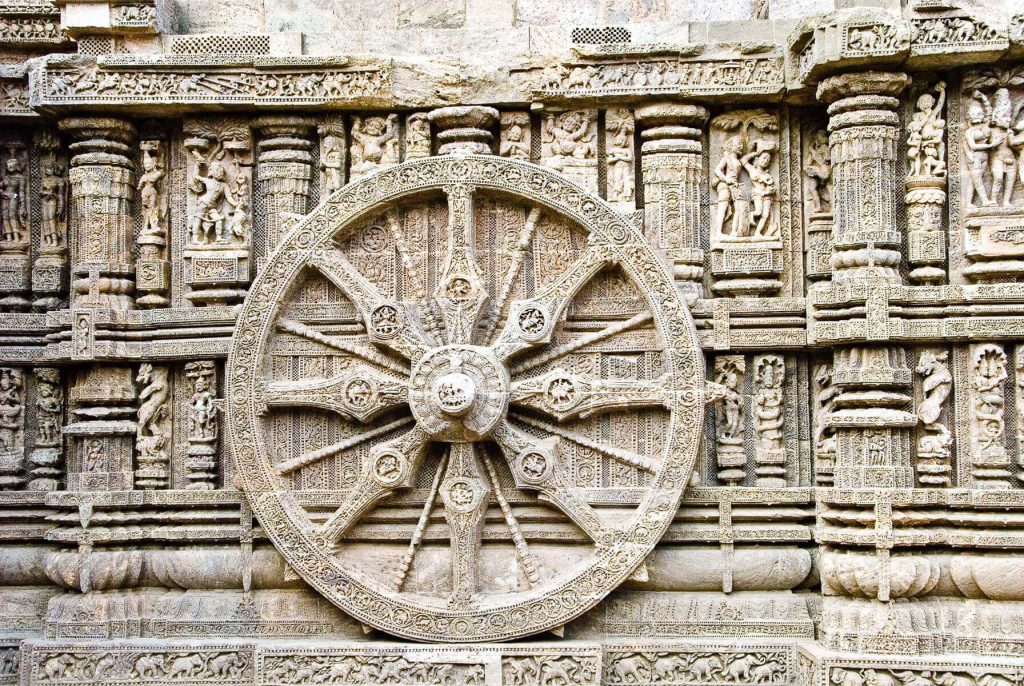
The wheel on the Sun Temple at Konark in Orissa, India. 13th CE. Photo Heather Elton
‘Dharma’ in Sanskrit means ‘teachings’; ‘Dhamma’ in Pāḷi. These are also called vehicles or yāna. According to the FPMT (Foundation for the Preservation of the Mahayana Tradition), there were three Turnings of Wheel of Dharma, and each is considered a major historical point that correspond with new developments in Buddhist thought. Though the teachings of all three turnings are said to have been spoken by the historical Buddha, the second and third turnings were not publicly known until centuries after the passing of Śākyamuni Buddha. These turnings help us to categorise the content, philosophical view and practical application of all the Buddhist teachings.
Out of these sermons emerged the three major schools of Buddhism – Theravada Buddhism (earliest historical period of Buddhism), Mahāyāna Buddhism (arose in 2-3 CE) and Vajrāyāna Buddhism (arose in 7-8 CE), which is largely associated with the Tibetan lineages.
- Theravada – Motivation: renunciation. Path: Contemplation on the Four Noble Truths and 12 links of interdependent origination. Result: Realisation of emptiness of personal self and liberation for oneself; dealing with afflictions; retreat from saṃsāra.
- Mahāyāna – Motivation: Bodhicitta. Path: Training in the Six Paramitas: Generosity, Precepts (Conduct). Perserverence (patience), Effort (energy), Samadhi (meditation), Wisdom. Result: Realising emptiness of personal self and all phenomena, and enlightenment for the sake of all sentient beings; dealing with afflictions; application of antidotes.
- Vajrāyāna – Motivation: Bodhicitta / Pure view. Path: The Six Paramitas through tantric means. Result: Realising emptiness of personal self and phemomena, and enlightenment for the sake of all sentient beings; dealing with afflictions; looking at the nature of mind.
The First Turning of the Wheel

Buddha gives his first sermon to five ascetics, in the Deer Park, at Sarnath, on the full moon day in July.
The first turning of the Wheel of Dharma – Dhammacakkappavattana Sutta – contains the essential teachings of the Four Noble Truths
and the Noble Eightfold Path. After listening to his sermon, the five ascetics became the Buddha’s disciples. Courtesy British Library.
(c.535 BCE.)
Śākyamuni Buddha gave his first teaching at Deer Park, in Sarnath, now part of greater Vārāṇasī in northeast India. A thousand people showed up. His five former companions were there (despite having shunned him when he turned his back on extreme practice and chose the Middle Way) and upon hearing Buddha’s teaching, and realising the brilliant insight and wisdom of his words, became his first disciples. They took refuge in the Buddha, Dharma and Sangha, known as the Triple Gem.
Dzongsar Khentsye Rinpoche discusses the First Turning of the Wheel in his book, India‘s Buddhist Holy Sites:
“What Buddha taught in Sarnath is that we don’t know what suffering really is. Everything we think will make us happy is either teetering on the edge of suffering or the cause of immediate suffering. It’s relatively easy to recognise the obvious sufferings of this world, but very difficult to perceive that the so called ‘good time’ some people have in saṃsāra is really suffering or leads to suffering. Buddha pointed out that, contrary to popular belief, suffering doesn’t land on us from an outside source, but is a product of our own emotional responses. He made it clear that however much we suffer, and however real that suffering and its causes may feel to us, it is in fact an illusion and does not exist inherently. This truth, Buddha tells us, is something we can fully realise for ourselves, and what’s more, he has shown us how by laying out a path for us to follow. Basically, try to remember, and appreciate, that a path that has the power to transcend saṃsāra and remove all our defilements actually exists.”
The First Turning is mainly concerned with abandoning negative actions of the body, speech and mind. Buddha taught the Four Noble Truths and the Noble Eightfold Path, as well as other important teachings that laid out the essential philosophical ‘view ‘upon which all of his later teachings are based. These include: No Self (Anātman), which might be a response to the Upaniṣadic quest for ātman, but Buddha clearly says that Atman doesn’t exist. And there is no Creator god. Dependent-arising, or Interdependent Origination, (pratītyasamutpāda), is a key concept where phenomena arise together in an interdependent matrix of cause and effect (karma) and have no self-existence from their side. Five Heaps, or five aggregates (skandhas), are comprised of the physical body, ideas/concepts, emotions, desires/volitions, self-consciousness. Impermanence (anitya), means that all things are in a state of transformation and change. All schools of Buddhism share these core teachings, but in particular, Theravada Buddhism. This turning was written in Pāḷi, in The Turning of the Wheel of Dhamma Sutta. All of the contents of the Pāḷi version of the Buddhist canon are used by Theravada Buddhists of Sri Lanka and Southeast Asia today.
Four Noble Truths
The Four Noble truths are the fundamental principles of existence that emerged from the Buddha’s realisation under the Bodhi Tree. They define the entire scope of Buddhist practice:
1. Life / Existence is suffering (dukha), unease, unsatisfactoriness
2. The cause of suffering is desire, thirst, craving and deluded attachment. These are caused by greed, aversion, delusion/ignorance .
3. Cessation of suffering (ie; emancipation from Saṃsāra is achieved through the elimination of desire and extinguishing the fires of greed, hatred and delusion.
4. The Noble Eightfold Path is the way to eliminate desire, leading to liberation from saṃsāra.
The Dhammacakkappavattana Sutta, records the Buddha’s first sermon:
“Now this, bhikkhus, is the noble truth of suffering: birth is suffering, ageing is suffering, illness is suffering, death is suffering; union with what is displeasing is suffering; separation from what is pleasing is suffering; not to get what one wants is suffering; in brief, the five aggregates subject to clinging are suffering.
Now this, bhikkhus, is the Noble Truth of the origin of suffering: it is this craving which leads to re-becoming, accompanied by delight and lust, seeking delight here and there; that is, craving for sensual pleasures, craving for becoming, craving for dis-becoming.
Now this, bhikkhus, is the noble truth of the cessation of suffering: it is the remainderless fading away and cessation of that same craving, the giving up and relinquishing of it, freedom from it, non-reliance on it.
Now this, bhikkhus, is the noble truth of the way leading to the cessation of suffering: it is this Noble Eightfold Path.”
Noble Eightfold Path
The Noble Eightfold Path aims to perfect the three essentials of Buddhist training and disciple – ethical conduct (sila), mental discipline (samadhi), wisdom (prajna).
1. Right view
2. Right thought (intention)
3. Right speech
4. Right action
5. Right livelihood
6. Right effort
7. Right mindfulness
8. Right concentration
Following the Noble Eightfold Path leads to the end of sorrow and the attainment of peace, enlightenment, and nirvana through moral, spiritual and intellectual perfection. It is discipline in body, word and mind, and has nothing to do with faith, prayer, worship or ceremony. Śākyamuni Buddha devoted himself to teaching these principles for the next 45 years of his life.
Dzongsar Khentsye Rinpoche discusses the path to liberation in his book, India‘s Buddhist Holy Sites:
“We now know that all of us, however bad we may consider ourselves to be, have the potential to become a Buddha. We also know that an Indian prince called Siddhārtha, who was just like us, fully developed that potential and, by doing so, demonstrated that it is possible to discover our Buddha Nature. If there were no path to liberation, if Buddha Śākyamuni had been the one and only person ever to achieve enlightenment, there’d be absolutely no hope for the rest of us and his first two statements would be nothing more than empty posturing. But Lord Buddha, in his great compassion, did teach the path to liberation, which gave all those interested in attaining enlightenment the choice of a variety of methods for achieving it. The Buddha was never dogmatic about his teachings; he never tried to force anyone to do as he suggested. Instead, he always recommended that we analyse everything he taught to establish for ourselves whether or not we think it’ll help us; and if it doesn’t make sense, we shouldn’t even try.”
The Second Turning of the Wheel
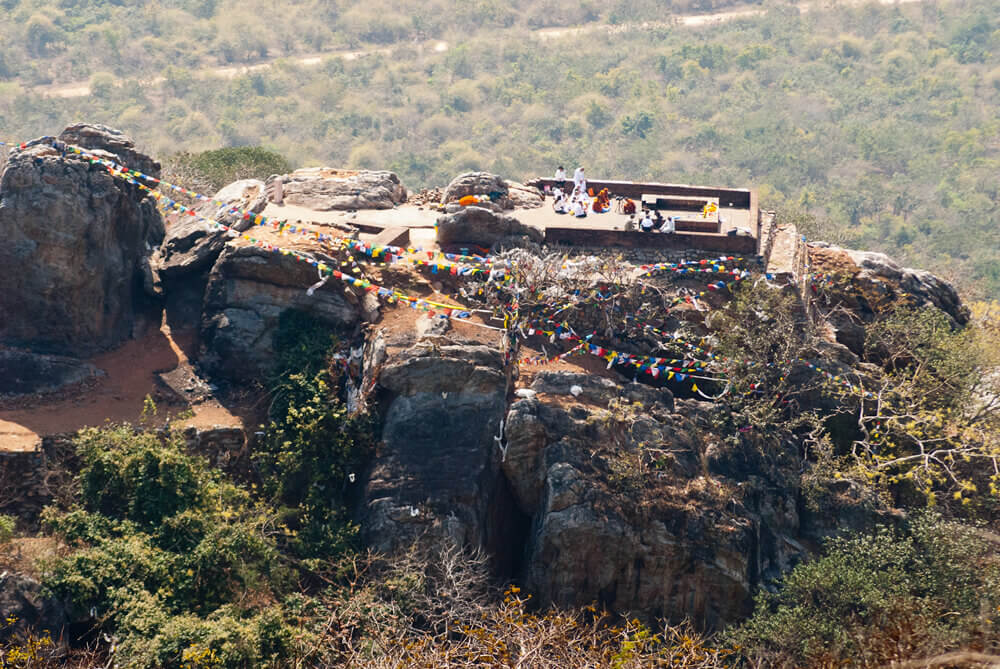
Vulture’s Peak, in Rajgiri, Bihar, India, is site of the Second Turning of the Wheel of Dharma. The Buddha taught Prajñāpāramitā
(The Heart of Perfection and Wisdom) that emphasises emptiness (Śūnyatā) and compassion (Karuna). Photo Heather Elton
The second turning of the Wheel took place at Vulture’s Peak, in Rajgiri, in the north eastern state of Bihar. The audience was comprised of Bodhisattvas (those who have taken a vow to stay on this earth until all sentient beings have awakened). Mañjuśrī, Nagarjuna and Avalokiteśvara were said to be there. Buddha taught The Heart of Perfection and Wisdom Sutra, also know as the Prajñāpāramitā, that emphasises emptiness (Śūnyatā) and compassion (Karuna). These two elements form Bodhicitta. Bodhi means ‘enlightenment’ or ‘awakening,’ and citta, means ‘mind’ or ‘consciousness.’ It requires a spontaneous wish to attain enlightenment motivated by great compassion for all sentient beings, accompanied by a falling away of the attachment to the illusion of an inherently existing self and phenomena. The distinguishing feature of the Mahāyāna (Greater Vehicle) School of Buddhism, that emerged out of the second turning of the Wheel of Dharma, is that the result of the path is realising emptiness of personal self and phenomena and enlightenment for the benefit of all sentient beings. Mahāyāna flourished at the beginning of the Common Era to 500-600 CE.
Here is the essence of the Buddha’s teachings, as told to Śāriputra by the noble bodhisattva Avalokiteśvara, in the Prajñāpāramitā:
“O Śāriputra, a son of noble family or daughter of noble family who wishes to practise the profound perfection of wisdom should regard things in this way: they should see the five aggregates to be empty of nature. Form is emptiness; emptiness is form. Emptiness is not other than form; form is no other than emptiness. In the same way, sensation, recognition, conditioning factors, and consciousness are emptiness.
Therefore, Śāriputra, all dharmas are emptiness; they are without characteristics; they are unrisen and unceasing; they are not tainted and not untainted; they are not deficient and not complete.
Therefore, Śāriputra, in emptiness, there is no form, no sensation, no recognition, no conditioning factors, no consciousness; no eye, no ear, no nose, no tongue, no body, no mind; no visible form, no sound, no odour, no taste, no texture and no mental objects; there is no eye element up to no mind element and as far as no mental consciousness element; there is no ignorance, no extinction of ignorance up to no old age and death, no extinction of old age and death. Likewise, there is no suffering, no origin, no cessation and no path, no wisdom, no attainment, and no non-attainment.
Therefore, Śāriputra, since bodhisattvas have no attainment, they rely on and abide by the perfection of wisdom. Since their minds are unobscured, they have no fear. They completely transcend error and reach the ultimate nirvāṇa. All the buddhas throughout the three times fully awaken to unsurpassed, genuine and complete enlightenment by means of the perfection of wisdom.
Therefore, the mantra of the perfection of wisdom—the mantra of great insight, the unsurpassed mantra, the mantra that equals the unequalled, the mantra that pacifies all suffering—is not false and should thus be understood as true. The mantra of the perfection of wisdom is proclaimed as follows:
[oṃ] gate gate pāragate pārasaṃgate bodhisvāhā – gone, gone, gone beyond, awakening, blessings.”
According to the Tibetans, the Prajñāpāramitā is the highest philosophical presentation of reality. It introduced a non-dual view. The Buddha taught that all persons and phenomena are characterised, not merely by selflessness, but by the more subtle and profound term, emptiness. It doesn’t mean ‘void,’ which is nihilistic. In other words, everything is utterly empty of, or lacking, any independent, unchanging essence, absolute nature, or any own way of being in and of itself. The Prajñaparamita has not only soothed the anxieties of countless beings, but has actually liberated a great many too.
The Mahāyāna School of Buddhism has two main traditions – founded by the mahasiddhas (great realised beings) and brilliant philosophers, Nāgārjuna (150 – 250 CE) and Asaṅga (300-390 CE). Nāgārjuna transmitted the Profound View lineage teachings of emptiness from Bodhisattva Mañjuśrī and laid the foundation for The Middle Way (Mādhyamika) school, while Asaṅga transmitted the teachings of the bodhisattva practices from Bodhisattva Maitreya (Future Buddha) and laid the foundation for Yogācāra, or Chittamatra, the doctrine of the Mind-Only (vijñapti-mātra) school that asserts that all phenomena are merely mind – the all-ground consciousness (Ālaya–vijñāna) manifesting as environment, objects and the physical body, as a result of habitual tendencies. Most important is the idea of samskaras (psychological imprints left in the subconscious by daily experiences that propel us to action and create habitual patterns) and vasanas (chains of samskaras), stored within the ālaya–vijñāna. Vasana means ‘to remain,’ ‘to dwell,’ ‘to persist [in memory].’ The term vasana is associated with subtle desire.
In the Mādhyamikalankara, Khenchen Bodhisattva describes the Yogācāra Mādhyamika school as “riding the chariot of two great philosophical systems, holding the reins of logic and reasoning.” The profound logic of Nagarjuna’s Mādhyamika system and the vast philosophical system of Asanga combined together in a single state of practice, when applied in meditation, will take us directly to the perfect state of buddhahood.
Buddha Nature and the nature of mind are key teachings in the second turning. All sentient beings have pure Buddha Nature – something considered to be radiant, luminous, clear light, cognisance – and are endowed with all encompassing compassion. ‘Original sin’ is not a concept in Buddhism. People stuck in saṃsāra believe that the emotions and feelings we experience through the five senses are ‘real’, yet the Buddha tells us that the very essence of mind is empty (nothing inherently exists singularly from it’s own side only; independent origination). Many Buddhist practices focus on taming the mind and taking responsibility for it in order to diminish suffering. We need to analyse how we perceive the world, recognise the lens through which we view it, and create our own lives. Then all negative emotions will dissolve and the qualities of love, compassion, wisdom will arise.
One of the beloved texts of Mahāyāna Buddhism, the Bodhisattvacaryāvatāra, is an 8 CE poem written by Bodhisattva Shantideva, a Buddhist Mahasiddha, poet, scholar and adept of the Mādhyamika philosophy of Nagarjuna. It gives precise advice for dealing with difficult people, emotions and situations. Shantideva was dedicated to the development of bodhicitta and guided people on the bodhisattva path through the practice of the Six Pāramitās (Perfections). His most well-known metaphor for approaching challenges in our lives points out the impossibility of living in a bubble-wrapped world:
To cover all the earth with sheets of hide—
Where could such amounts of skin be found?
But simply wrap some leather round your feet,
And it’s as if the whole earth had been covered!
Instead of covering the planet with leather, just slip on a pair of shoes. Shantideva’s point is that you can’t control other people’s behavior, but you do have control over your reactions to them. Cultivate your mind, rather than try to protect yourself from harm or irritation by trying to control the world. This passage is useful as a reminder that we are accountable for our own behavior internally and externally.
When Shantideva delivered his thesis – the Bodhisattvacaryāvatāra (Way of the Bodhisattva) – at Nalanda University, he levitated and vanished into thin air in front of a group of monks who had initially scorned him for being lazy.

A rare manuscript of the Prajñāpāramitā (The Heart of Perfection and Wisdom) at the Bikramashila Mahabiha, in Kathmandu, Nepal. Photo Heather Elton
A few years ago, in Kathmandu, I had darshan (to ‘see’ and be ‘seen’) with one of the earliest manuscripts of the Prajñāpāramitā (The Heart of Perfection and Wisdom). We waited in a sequestered area of the Stham Vihara, also known as the Bikramashila Mahabiha, built by Mahasiddha Jowo Atisha, in 1041 CE, to honour Kasyapa Buddha, while the manuscript was brought out in eight aluminium trunks. The Prajñāpāramitā is said to have been recorded by Bodhisattva Mañjuśrī at Vulture’s Peak, and entrusted to Nagarjuna, who brought from the Naga Realm. The 800-year-old, one hundred thousand sloka, or 2000 page manuscript, written in gold ink on lapis lazuli paper is one of the most beautiful objects I’ve seen. It was luminous.
The Third Turning of the Wheel

The third turning of the Wheel of Dharma, is commemorated in Vaiśālī with a large hemispheric brick stupa guarded by a life-size lion,
sitting atop a 2,300 year old pillar built by Emperor Aśoka. The stupa contains the relics of Ananda (Buddha’s attendant monk and cousin).
The Third Turning of the Wheel of Dharma is said to have taken place in Vaishali, Nepal, (and other places). The teachings are attributed to both the Mahāyāna and Vajrāyāna Buddhist schools, are build on the foundation of the two great chariots -the Mādhyamika system of Nagarjuna and the philosophical system of Asanga. Vajrāyāna – the Thunderbolt Vehicle or Diamond Vehicle – associated with the Tantric practices of Tibetan and Himalayan Buddhists, emerged from this turning.
Like Mahāyāna Buddhists, Vajrāyāna practitioners keep the Bodhisattva vow of bodhicitta, but have the non-dual ‘pure view’. There is a distinction between Relative and Absolute truths. The Third Turning focuses on the highest forms of Ati yoga, and specifically how to abandon clinging to ‘emptiness,’ and is considered the ‘ultimate and final truth’ of the Buddhism. The earlier turnings, while being authentic, are considered flawed, or incomplete, and require interpretation. (We’ll discuss more about Vajrāyāna Buddhism and Padmasambhava (or Guru Rinpoche), who Tibetans refer to as ‘the Second Buddha’, when we get to 8 CE.)
To summarise the three vehicles of Buddhism – the First Turning of the Wheel of Dharma constructed a path to liberation through the Four Noble Truths and 12 links of interdependent origination to overcome afflictions of mind; the Second Turning used logic and reason to refute the path by teaching the absence of characteristics (of form and emptiness) to overcome clinging to the self and phenomena; and, the Third Turning redeems the path by presenting a deeper understanding of the nature of Ultimate Truth to overcome clinging to emptiness.
12. Passing into Mahaparinirvāṇa

A stone carving of Śākyamuni Buddha in Mahaparinirvāṇa. Mahaparinirvāṇa is the final passing beyond suffering
manifested by buddhas and highly-realised masters at the end of their lives. Śākyamuni Buddha, at the age of 80,
became absorbed in meditation and passed into Parinirvāṇa. This event is commemorated on Saga Dawa Düchen,
the full moon day of the 4th month in the Tibetan calendar. Ajanta Caves, Maharastra, India. C. 200 BCE. Photo Heather Elton
After 45 years of teaching, Śākyamuni died, c. 480 BCE, at the age of 80, in the small town of Kushinagar in northeast India. As popular legends say, he died from food poisoning after being given rotten pork in his offering bowl. As was customary at the time, monks accepted whatever was offered without desire or aversion. In a biographical event known as Mahaparinirvāṇa, Śākyamuni Buddha became absorbed in meditation and passed into nirvana (never to be born again). Nirvana is the ultimate spiritual goal in Buddhism and releases us from rebirth in saṃsāra. At that moment, there was an earthquake, “the earth trembled, the stars shot from the heavens, and in the ten quarters of the sky there burst forth flames and the sounds of celestial music.”
The Buddha entered parinirvāṇa, or nirvana-after-death, which occurs at the time of death for those who’ve attained nirvana during his or her lifetime. Passing into parinirvāṇa is, of all the Buddha’s teachings, the one that transcends all concepts about time, birth, sickness, old age, death, saṃsāra and nirvana, and cannot be bound by any kind of dualistic phenomena. Those of us who have yet to awaken to our true nature are still bound by dualist notions of time, space, quantity and speed.
Buddha’s last words on his death bed, are said to have been:
“Behold, O monks, this is my last advice to you. All component things in the world are changeable. They are not lasting. Work hard to gain your own salvation.”
And, for a final word, Dzongsar Jamyang Khentsye Rinpoche, says in his book, India‘s Buddhist Holy Sites:
“Buddha’s last statement tells us that having attained enlightenment he didn’t become an immortal saviour who would live permanently as a truly existing deity or god, or that one day he would come back to judge us. Nor did he become the kind of being who could be pleased by the lights and incense he was offered. A buddha cannot be bribed; no amount of bootlicking will affect his judgement; his compassion does not manifest in the form of rewards offered or punishment meted out; and he can never be annihilated. Although, strictly speaking, he’s not ‘immortal’ in a worldly sense, neither does he no longer exist. To become a buddha and reach Parinirvana is to go beyond time, space and everything, including the concept of ‘buddha’. The symbolic Buddha whose golden skin we gaze on, who embodies the thirty-two major and eighty minor marks, has bare feet, holds a begging bowl and teaches his disciples, is a ‘relative’ manifestation. Once Lord Buddha passed into Parinirvana, he went beyond all concepts of gender, time and space and has now become the ‘absolute Buddha’. ♦
T A K E A W A Y
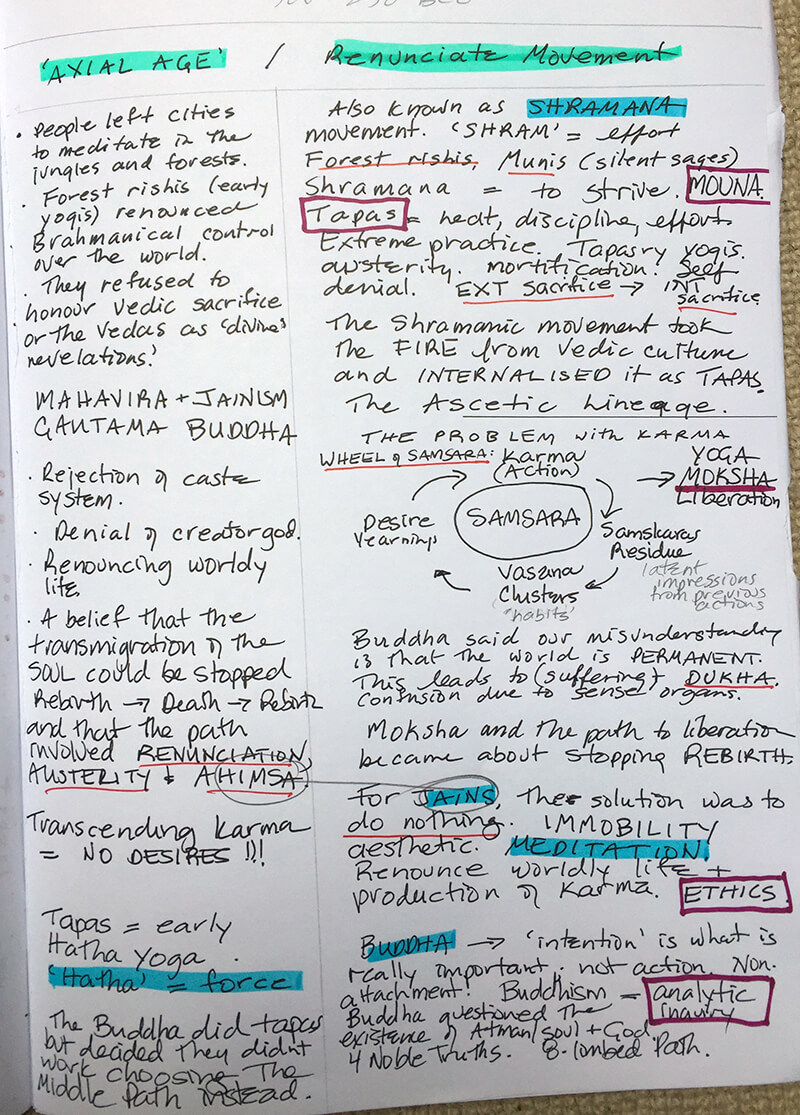


BUDDHISM
Buddhism is a philosophical system, not a religion. There is no God and no Original Sin. If there is one word to describe all the teachings it would be ‘analysis’.
D A T E S
c. 563-483 BCE
B I O
Siddhārtha Gautama Buddha was born in Lumbini, raised as a Prince, saw four sights – ageing, sickness, death, and a holy person – that led to his renunciation from a life of luxury in the palace, to become an ascetic yogi doing extreme yoga practices, realising that those practices did not produce Moksha (liberation), finding the Middle Way, awakening under the Bodhi tree in Bodhgaya, teaching the dharma for 45 years, and passing into Parinirvana at 80. He is known as ‘Gautama’, the name of the clan into which he was born in Śākya, ‘Bhagavat’, meaning a Blessed Lord, by his disciples; Siddhārtha refers to ‘one who is accomplished’; and Buddha, ‘the Awakened One. He referred to himself as ‘Tagathata’. Gautama is also known as Śākyamuni Buddha, the ‘first’ Buddha, or the ‘historical’ Buddha.
T E A C H I N G S
The Three Turnings of the Wheel of Dharma:
1. Theravdan Buddhism – Early teachings of the historical Buddha. Four Noble Truths.
2. Mahāyāna Buddhism – Mādhyamika and Yogācāra lineages. Buddha Nature. Emptiness and compassion. Dedicated to the merit of all sentient beings. c. Beginning of the Common Era to 500-600 CE.
3. Vajrayāna Buddhism – Tantra or Tibetan Buddhism. C. 600-800 CE
K E Y C O N C E P T S
Four Noble Truths
1. Suffering, unease, unsatisfactoriness – duḥkha
2. Cause of suffering – thirst, desire, craving (tṛṣṇā). Three fundamental defilements are greed (rāga, lobha), aversion (dveṣa), delusion (moha, avidyā).
3. Cessation of suffering – nirvāṇa (1) blowing out, extinguishing (the fires of greed, hatred and delusion); (2) the final condition of the Buddha and arhats upon the extinction of defilements; (3) the unconditioned realm known at the moment of awakening.
4. Noble Eightfold Path -1.right view, 2. right intention, 3. right speech, 4. right action, 5. right livelihood, 6. right effort, 7. right mindfulness, 8. right concentration.
V I E W
The essential philosophical ‘view ‘in Buddhism that all schools agree on:
DUḤKHA Suffering, unease, unsatisfactoriness. What will satisfy you? Something you can trust 100%. But if everything is uncertain, how can you trust it? Everything is 100% not satisfying.
ANITYA Impermanence; all things are in a state of transformation and change.
ANĀTMAN No Self. No Creator God. A BIG statement. Opposes Vedantic accepted notions of ātman and Brahma in the Upanishads.
PRATĪTYASAMUTPĀDA Dependent Arising, or Interdependent Origination, where phenomena arise together in an interdependent matrix of cause and effect (karma) and have no self-existence from their side. Nothing is at it appears. There is no solid, independent existence. Everything is compounded.
ŚŪNYATĀ Emptiness. Śūnyatā is part of the Perfection of Wisdom, or Prajñā-pāramitā, (Mahāyāna teachings and is twinned with COMPASSION Karunā. Contemplate: ‘Here, O Śāriputra, form is emptiness and the very emptiness is form; emptiness does not differ from form, form does not differ from emptiness; whatever is form, that is emptiness, whatever is emptiness, that is form, the same is true of feelings, perceptions, impulses, and consciousness.
SKANDHAS Five heaps, or five aggregates: physical body, feelings, ideas/concepts, desires/volitions, self-consciousness
P R A C T I C E S
To be accepted on to the Buddhist path and learn Vajrayāna practices, one needs to take refuge in the Triple Gem (Buddha, Dharma and Sangha). This leads to Ngondro, or the Preliminary Practices (Refuge, Boddhicitta, 100,000 Prostrations, Purification, Mandala Offering, Kusali, Guru Yoga), culminating in a 3-year retreat, followed by individual yidyam (deity) sadhanas, suited to the practitioner. This is done while observing the Eightfold Noble Path.
Meditation
Meditation is the actual method of transforming the mind. There are two main kinds – Śamata (calm abiding) and Vipaśyanā (insight, wisdom).
Asana
Vajrayāna tantric yoga practices have been ‘secret’ and only for the initiated to practice. In the past couple of years, scholars have shed new light on these practices. Ian Baker’s books, The Dalai Lama’s Secret Temple and Tibetan Yoga, reveal the secret tantric practices of Ati Yoga, of the Dzogchen lineage, in a flowing sequence of 23 yogic movements linking body, breath and mind. These trulkhor, or yogic exercises, are used to open the body’s pathways of subtle energy. Jim Mallinson (Director of the Hatha Yoga Project at SOAS) has discovered a 12th CE manuscript on Hatha Yoga, the Amṛtasiddhi, that is actually a Buddhist Vajrayāna text. This is the earliest text that mentions the term Hatha Yoga and describes a few practices of the time.
R E L E V A N C E
Buddhism and yoga are closely intertwined. Many yoga lineages and schools believe that yoga is a science to control the mind, something that is necessary prior to liberation. It is likely the Buddha practiced many disciplines we would consider yogic: sitting meditation, pranayama, bandhs and mudras, mantras. There has been a long running dispute between Buddhism and Orthodox Hinduism over the nature of the Self. Orthodox Hinduism teaches there is an eternal unchanging core, the ātman, whilst Buddhism teaches there is no such thing, anātman.
T E X T S
Theravdan Early Buddhism: Tripiṭaka (three baskets) – Sūtra (discourses), Vinaya (discipline), Abhidharma (further dharma). Three canons survive: Pāḷi Canon, Chinese Tripiṭaka, Tibetan Kanjur.
Texts from Mahāyāna Buddhism include the Prajñāpāramitā (The Perfection of Transcendent Wisdom, the Tathāgatagarbha Sūtra on Buddha Nature, Vimalakīrti Sūtra on non-dualism, Nāgārjuna’s Mādhyamika-kārikā, and Śāntideva’s Bodhisattvacaryāvatāra (Way of the Bodhisattva).
Buddhist Tantras are key texts in Vajrāyāna and can be found in the Tibetan Kangyur which contains translations of almost 500 tantras, but individual sadhanas (tantric techniques) are also used. Anuttarayogatantra (Higher Yoga Tantra) is known in the Nyingma school as Mahayoga. The most influential Higher Tantras are found in the Guhyasamāja Tantra, the Hevajra Tantra, the Cakrasamvara Tantra, and the Kalacakra Tantra. The Nyingma school of Tibetan Buddhism also has Dzogchen tantras, a special class of texts called terma believed to be composed and hidden by tantric masters and discovered by other tantric masters known as tertöns. Many of the terma texts are said to have been written by Padmasambhava, who is particularly important to the Nyingmas. Probably the best known terma text is the so-called Tibetan book of the Dead, the Bardo Thodol.
FURTHER READING
Conze, Edward. 2001. Buddhist Wisdom: The Diamond Sutra and the Heart Sutra. Vintage Spiritual Classics: New York.
Gethin, Rupert. 1998. The Foundations of Buddhism. Oxford University Press: Oxford and New York.
King, R., 2000. Indian Philosophy: An Introduction to Hindu and Buddhist Thought. Maya: New Delhi.
Rahula, Walpola. 1959, 2012. What the Buddha Taught. Oneworld: Oxford.
Missed the beginning? Start with Part One – A Yoga History in a Nutshell: Introduction
Part 7 on Classical Yoga is coming soon.
This series of articles in A History of Yoga is intended for students on my 200-hour Yoga Teacher Training programs and explores the philosophy and practice of yoga throughout it’s history. Many of the ideas are inspired by the teachers who have taught Yoga Philosophy on my Yoga Teacher Training programs. Emil Wendel, Jim Mallinson, Mark Singleton, Ian Baker, John Weddepohl, Daniela Bevilacqua, Matthew Clark, Daniel Simpson and Ruth Westoby. The Hatha Yoga Project and Centre of Yoga Studies at SOAS, and online courses with Seth Powell (Yogic Studies), have also been influential. Gratitude to Richard Freeman who brings the philosophy back to the mat. As always, deep gratitude to my guru, Dzongsar Jamyang Khentsye Rinpoche, for his presence and teachings. 🙏🏽 Any misrepresentations of facts or dharma are totally of my own doing for which I’m sorry.
4 Comments
Leave A Comment
You must be logged in to post a comment.

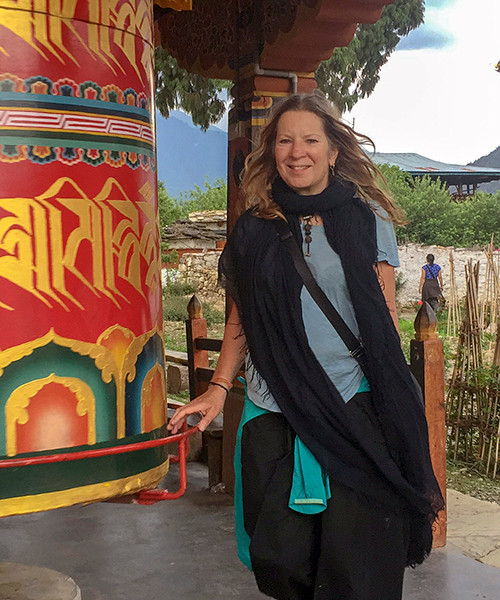
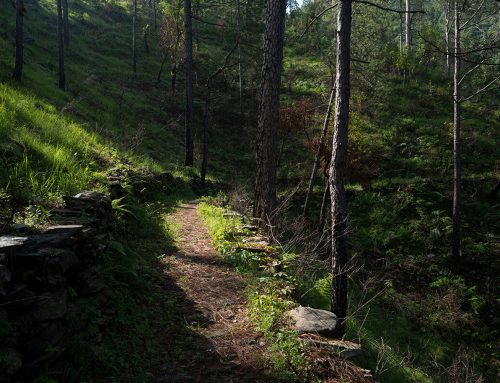
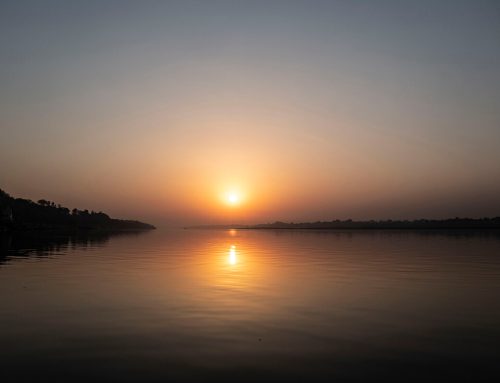


Really enjoyed your article . Thanks for all the information :)
Thank you for taking the time to read my article. I’m glad that you found it useful. 🙏
Really enjoyed your article . Thanks for all the information :)
Thank you for taking the time to read my article. I’m glad that you found it useful. 🙏